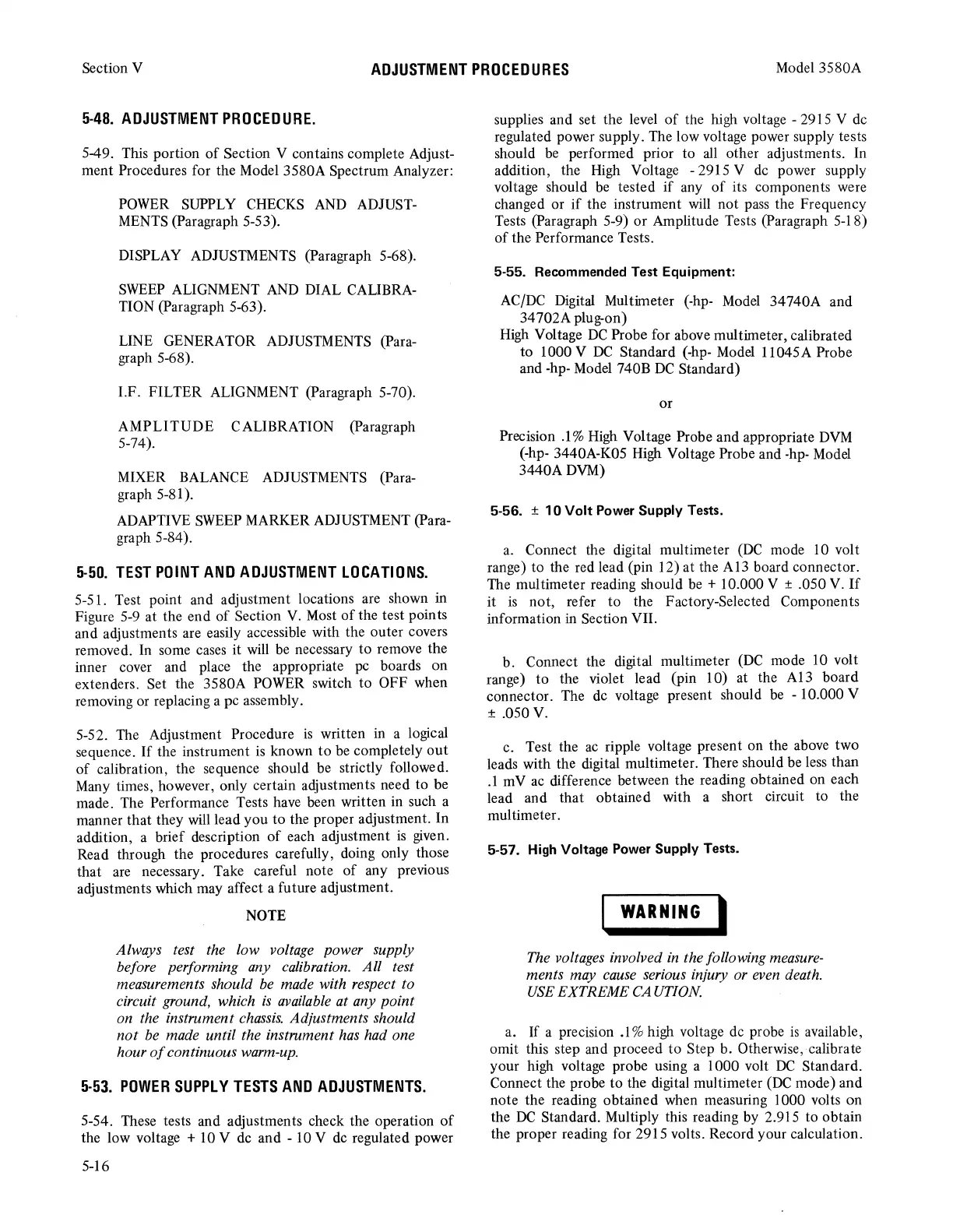Section V
ADJUSTMENT
PROCEDURES
Model 3580A
5-48.
ADJUSTMENT
PROCEDURE.
5-49. This portion
of
Section V contains complete Adjust-
ment Procedures for the Model 3580A Spectrum Analyzer:
POWER SUPPLY CHECKS AND ADJUST-
MENTS (Paragraph 5-53).
DISPLAY ADJUSTMENTS (Paragraph 5-68).
SWEEP
ALIGNMENT AND DIAL CALIBRA-
TION (Paragraph 5-63).
LINE GENERATOR ADJUSTMENTS (Para-
graph 5-68).
I.F. FILTER ALIGNMENT (Paragraph 5-70).
AMPLITUDE
CALIBRATION (Paragraph
5-74).
MIXER BALANCE ADJUSTMENTS {Para-
graph
5-81
).
ADAPTIVE
SWEEP
MARKER ADJUSTMENT (Para-
graph 5-84).
5-50.
TEST
POINT
AND
ADJUSTMENT
LOCATIONS.
5-51. Test point and adjustment locations are shown in
Figure 5-9 at the
end
of
Section
V.
Most
of
the test points
and adjustments are easily accessible with the outer covers
removed. In some cases it will be necessary
to
remove the
inner cover and place the appropriate pc boards
on
extenders. Set the 3580A POWER switch
to
OFF when
removing or replacing a pc assembly.
5-52. The Adjustment Procedure
is
written in a logical
sequence.
If
the instrument
is
known
to
be completely
out
of
calibration, the sequence should be strictly followed.
Many times, however, only certain adjustments need to be
made. The Performance Tests have been written in such a
manner that they will lead
you
to
the proper adjustment.
In
addition, a brief description
of
each adjustment
is
given.
Read through the procedures carefully, doing only those
that are necessary. Take careful note
of
any previous
adjustments which may affect a future adjustment.
NOTE
Alw~s
test the low voltage power supply
be/
ore
per/
arming any calibration.
All
test
measurements should be made with respect to
circuit ground, which
is
available at any point
on the instrument
chassis.
Adjustments should
not
be made until the instrument has had one
hour
of
continuous warm-up.
5-53.
POWER
SUPPLY
TESTS
AND
ADJUSTMENTS.
5-54. These tests and adjustments check the operation
of
the low voltage + 10 V de and - 10 V de regulated power
5-16
supplies and set the level
of
the high voltage - 2915 V de
regulated power supply. The low voltage power supply tests
should be performed prior to
all
other adjustments. In
addition, the High Voltage - 2915 V de power supply
voltage should be tested
if
any
of
its components were
changed or
if
the instrument will not pass the Frequency
Tests (Paragraph 5-9)
or
Amplitude Tests {Paragraph 5-18)
of
the Performance Tests.
5-55. Recommended Test Equipment:
AC/DC Digital Multimeter (-hp- Model 34740A and
34 702A plug-on)
High Voltage
DC
Probe for above multimeter, calibrated
to 1000 V
DC
Standard (-hp- Model 11045A Probe
and -hp- Model 740B
DC
Standard)
or
Precision
.1
% High Voltage Probe and appropriate
DVM
(·hp- 3440A-K05 High Voltage Probe and -hp- Model
3440ADVM)
5-56. ±
10
Volt Power Supply Tests.
a. Connect the digital multimeter
(DC
mode 10 volt
range) to the red lead (pin 12) at the
Al3
board connector.
The multimeter reading should
be+
10.000 V ± .050 V.
If
it
is
not, refer
to
the Factory-Selected Components
information in Section VII.
b. Connect the digital multimeter
(DC
mode 10 volt
range)
to
the violet lead {pin 10) at the A13 board
connector. The de voltage present should
be
- 10.000 V
± .050
v.
c. Test the
ac
ripple voltage present on the above two
leads with the digital multimeter. There should be less than
.1
m V
ac
difference between the reading obtained on each
lead and that obtained with a short circuit to the
multimeter.
5-57.
High
Voltage Power Supply Tests.
WARNING
I
The voltages involved in the following measure-
ments may cause serious injury or even death.
USE EXTREME CAUTION.
a.
If
a precision
.1
% high voltage de probe
is
available,
omit this step and proceed
to
Step b. Otherwise, calibrate
your high voltage probe using a 1000 volt
DC
Standard.
Connect the probe
to
the digital multimeter
(DC
mode)
and
note the reading obtained when measuring 1000 volts
on
the
DC
Standard. Multiply this reading by 2.915 to obtain
the proper reading for 2915 volts. Record your calculation.

